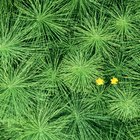
Grocery stores stock shelf after shelf of jelly varieties, but some of the best tasting jellies can be made right in your own kitchen with your favorite fruit juices and the right recipe. Most recipes call for an acid such as lemon juice to help transform the fruit juice into jelly. Adding the lemon juice and following your chosen jelly recipe meticulously, ensures good results.
Gel Formation
An acid, like lemon juice, works with natural fruit pectin to form insoluble fibers, which promote gel formation by absorbing juice. Fruit cannot turn to jelly without adequate amounts of acid. Too little acid and gel will not form. Too much acid and the gel that does form loses liquidity. Fruits that do not contain enough acid to form jelly require additional acids to get the job done.
Alternatives
Most jelly recipes call for lemon juice as the standard, but you may substitute citric acid -- usually sold in powdered form -- in place of it. The two acids are not equal in volume, so you must adjust the amount of ingredients when substituting. Use 1/8 teaspoon of citric acid for every tablespoon of lemon juice. You may also use vinegar -- 2 tablespoons in place of every tablespoon of lemon juice -- but this may alter the taste of the jelly.
Tartness Test
A simple test helps to determine if lemon juice is needed. Add 1 teaspoon of bottled lemon juice to a small cup. Add 3 tablespoon of water and 1/2 teaspoon sugar to the lemon juice and stir. Take a sip of the lemon juice, then take a sip of the fruit juice. The fruit juice you are using for jelly should taste as tart as the lemon juice. If it doesn’t, more acid is needed.
Ratios
Just as too little acid makes jelly-making close to impossible, too much acid results in instability. Proper ratios of acid to fruit juice are important. Don’t overdo it with the lemon juice. For every 1 cup of fruit juice, add 1 tablespoon lemon juice Avoid using more than 8 cups of juice when making a single batch of jelly. Larger amounts of fruit juice rarely yield well-formed jelly.
Related Articles

What Causes Homemade Jelly to Form ...

How to Make a Lip Mask for Extremely ...

How to Cook Agar-Agar Jam

How to Make a Fruit Reduction

Instructions for Using Mandelic Acid

How to Color White Frosting to Make ...

How to Make Homemade Liquid Rouge

How to Respond to a Compliment From a ...

Review of New-Skin Scar Therapy

How to Send Metal in an Envelope

How to Use Aspirin for Razor Bumps

What Is Certo Used For?

How to Get Acid Stain Out of Clothes

How to Make Chapstick Without Wax & ...

How to Remove the Back Cover of a ...

How to Cook Down Apple Juice to Make ...

Horsetail vs. BioSil

How to Substitute Mayonnaise for Sour ...

Substitute for Sorghum in Gingerbread

Active Ingredients in Mederma
References
- University of Kentucky Cooperative Extension Service: The Science of Jam and Jelly Making
- Iowa State University Extension and Outreach: Canning: Fruit Spreads
- University of Wisconsin Cooperative Extension: Making Jams, Jellies and Fruit Preserves
- The Ohio State University: Jams, Jellies and Other Fruit Spreads
Writer Bio
Jonae Fredericks started writing in 2007. She also has a background as a licensed cosmetologist and certified skin-care specialist. Jonae Fredericks is a certified paraeducator, presently working in the public education system.
Photo Credits
Eising/Photodisc/Getty Images